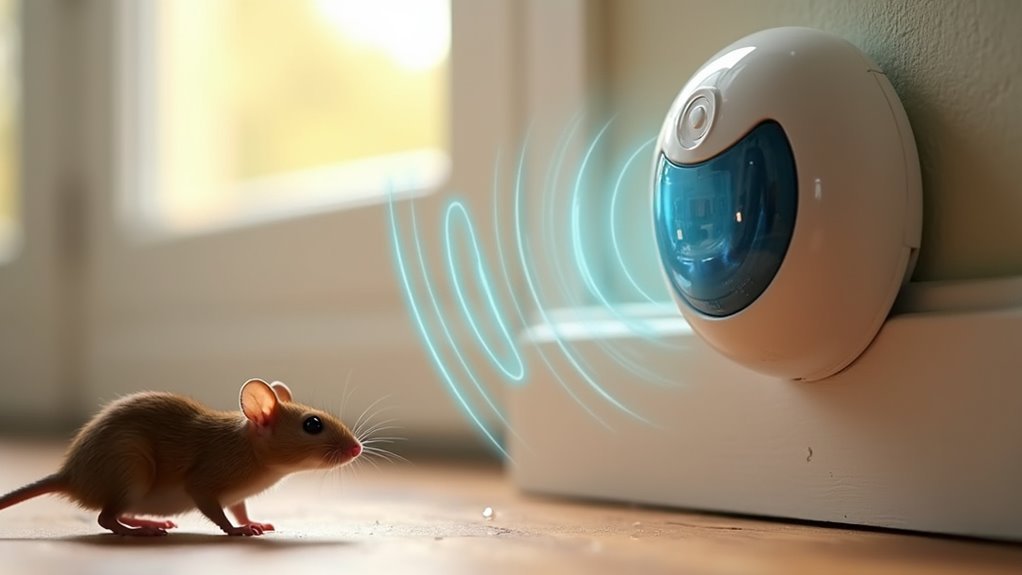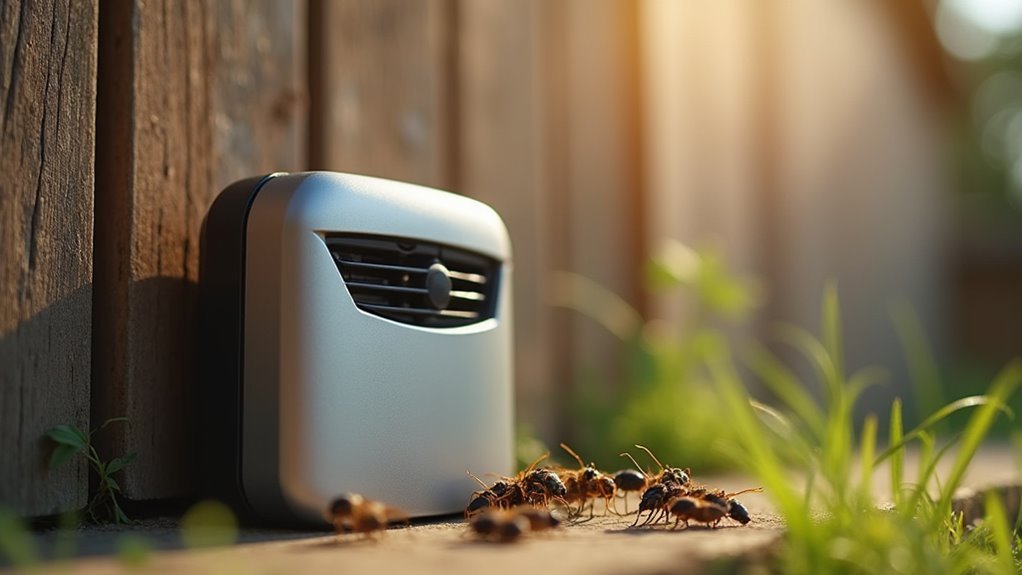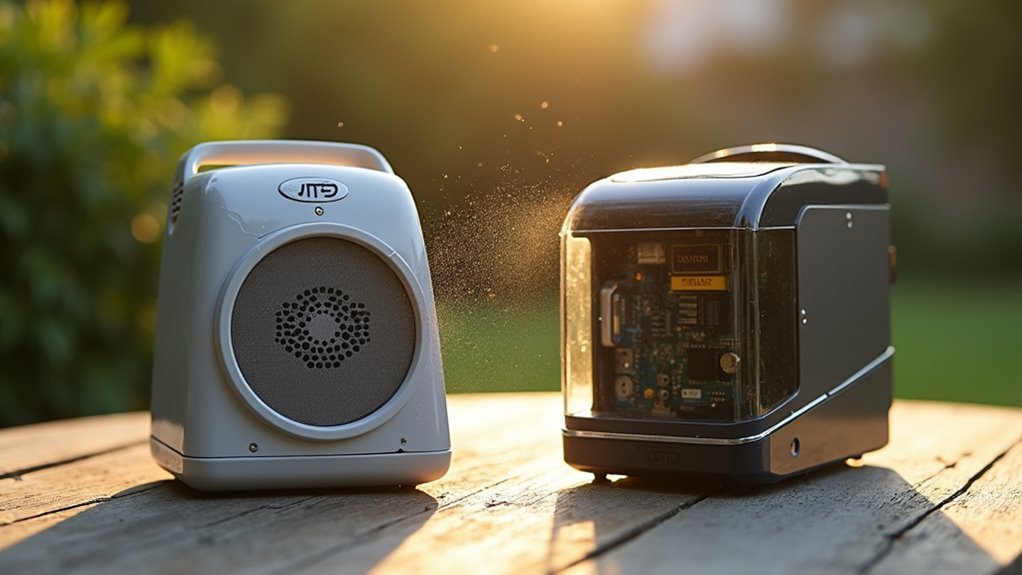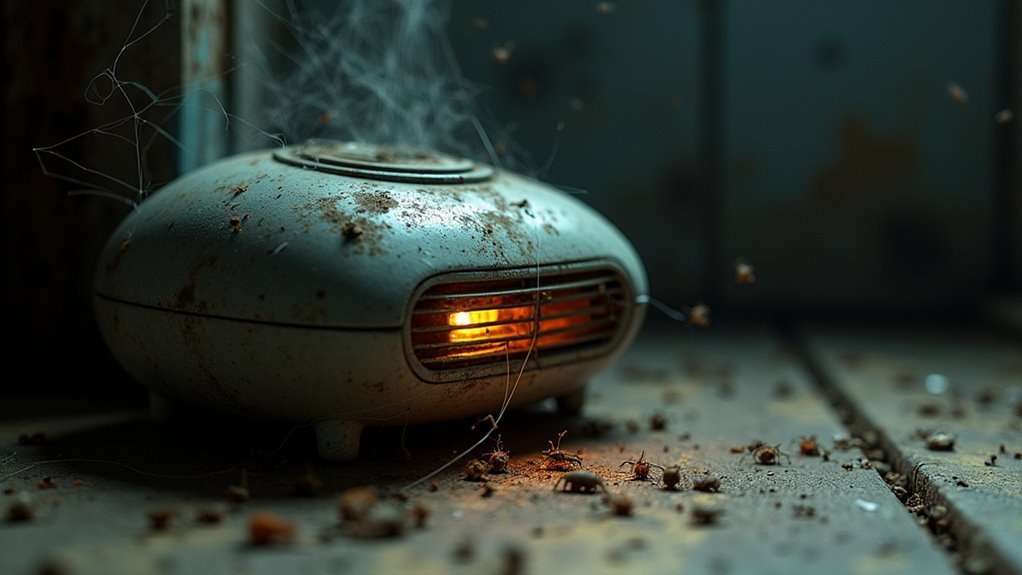Your ultrasonic pest repeller stops working effectively because its internal components gradually deteriorate from constant operation, typically lasting only 3-5 years before sound output weakens. Pests also develop behavioral resistance after consistent exposure, becoming desensitized to the frequencies. Environmental factors like humidity, dust, and furniture obstruct sound waves, while cheaper models fail faster due to inferior materials. The device’s limited 20-30 foot range creates dead zones where pests can hide and adapt more quickly to the sounds.
The Science Behind Ultrasonic Sound Waves and Pest Behavior

While ultrasonic pest repellers promise a chemical-free solution to your pest problems, they operate on a fundamentally flawed premise. These devices emit ultrasonic sound waves between 20 kHz and 100 kHz, frequencies supposedly designed to disrupt pest communication and navigation.
However, scientific studies reveal that common pests like bed bugs and cockroaches show little to no response to these frequencies.
Scientific research demonstrates that bed bugs, cockroaches, and similar household pests remain largely unaffected by ultrasonic frequency emissions.
You’ll find that environmental factors greatly compromise these pest control methods’ effectiveness. Humidity and background noise interfere with sound wave transmission, while furniture and walls block their limited 20-30 foot range.
Most critically, pests develop behavioral resistance over time, adapting to the constant sound exposure. This adaptation renders the devices increasingly ineffective, allowing pest activity to resume despite the ultrasonic intervention.
Component Degradation and Electronic Wear Over Time
Even if your ultrasonic pest repeller’s indicator light continues glowing, the device’s internal components deteriorate considerably over its typical 3-5 year lifespan.
Component degradation occurs gradually as electronic components wear down from constant operation. Environmental factors like humidity, dust, and heat accelerate this deterioration within ultrasonic devices.
You’ll notice the sound output frequency weakens over time, even when the unit appears functional. This diminished frequency directly impacts the device’s effectiveness against pests. The declining electronic components can’t maintain the consistent ultrasonic waves needed for proper pest control.
Unfortunately, this internal wear isn’t visible from the outside. Your repeller might look perfectly normal while its core functionality degrades.
This explains why previously effective ultrasonic devices eventually fail to keep pests away.
Pest Adaptation and Habituation to Ultrasonic Frequencies

Beyond the mechanical failure of ultrasonic devices, pests themselves develop resistance to the very frequencies meant to repel them. When you initially install these repellers, they may show promise, but pest adaptation quickly undermines their effectiveness.
Through habituation, rodents and other pests become desensitized to ultrasonic frequencies after consistent exposure, no longer perceiving them as threats.
Pests quickly adapt to ultrasonic repellers through habituation, becoming completely desensitized to frequencies that once deterred them effectively.
You’ll notice that certain species develop behavioral resistance, completely ignoring the sounds while continuing their normal activities. This adaptation process accelerates when environmental factors like background noise and physical barriers reduce the ultrasonic waves’ intensity.
The limited 20-30 foot effective range also allows unaffected pests to reinfest areas, creating ongoing pest infestations despite your investment in these devices.
Environmental Factors That Reduce Device Performance
Environmental conditions in your home actively work against your ultrasonic repeller’s performance from the moment you plug it in.
You’ll find that humidity absorbs the sound waves before they reach pests, while dust gradually clogs the device’s internal components and reduces output strength.
Heat from your home’s climate control system degrades the electronic parts over time, causing the repeller to weaken and eventually fail.
Humidity Absorbs Sound Waves
When moisture saturates the air around your ultrasonic pest repeller, it creates an invisible barrier that weakens the device’s effectiveness. High humidity levels absorb sound waves, particularly those in the ultrasonic range, causing significant power loss as frequencies travel through moisture-laden air.
This absorption dramatically reduces your device’s range and impact, making effective control increasingly difficult.
Environmental factors like rain and humidity interfere with ultrasonic sound transmission, causing waves to scatter rather than reach their intended targets. You’ll notice diminished performance during humid seasons when moisture increases sound attenuation.
Proper device placement becomes critical, as scattered waves can’t maintain the consistent frequency patterns needed for pest deterrence. Over time, this humidity-induced interference compounds, gradually rendering your ultrasonic repeller less reliable for long-term pest management.
Dust Clogs Internal Components
Dust particles silently infiltrate your ultrasonic pest repeller’s housing, gradually blocking the speaker grilles and internal mechanisms that generate essential sound frequencies.
When humidity combines with dust accumulation, sticky clumps form that obstruct your device’s emission pathways. This physical blockage prevents ultrasonic waves from reaching their intended targets at full strength.
You’ll notice your repeller’s effectiveness diminishing as dust absorbs and scatters the sound waves before they can travel their normal range. The accumulated debris acts like a sound dampener, reducing the device’s ability to create the high-frequency environment that deters pests.
Regular maintenance becomes vital for peak performance. You can restore your repeller’s functionality by carefully cleaning the speaker grilles and internal components, removing dust buildup that compromises ultrasonic transmission and overall pest control effectiveness.
Heat Degrades Electronic Parts
Heat poses an even greater threat to your ultrasonic repeller’s longevity than dust buildup. When temperatures soar, the electronic parts inside your device begin deteriorating rapidly. This thermal stress causes internal components to break down, directly reducing your repeller’s sound output and overall effectiveness.
Direct sunlight creates particularly harsh conditions for ultrasonic repellers, causing devices to overheat and accelerating component degradation. You’ll notice diminished performance as the heat weakens your device’s ability to produce strong ultrasonic emissions.
The degradation process isn’t immediate, but consistent heat exposure gradually destroys sensitive circuitry. Your repeller’s internal temperature rises beyond safe operating levels, causing permanent damage that can’t be reversed.
This thermal breakdown greatly shortens your device’s lifespan and pest-control capabilities.
Limited Range and Sound Wave Interference Issues
You’ll quickly discover that ultrasonic repellers can’t reach beyond 20-30 feet, severely limiting their coverage in larger homes or multiple rooms.
Your furniture, walls, and other objects block these sound waves, creating dead zones where pests can hide undetected.
You’ll also find that everyday household noise from appliances and electronics interferes with the ultrasonic frequencies, reducing their already limited effectiveness.
Sound Wave Obstruction
Even when ultrasonic repellers function properly, they’re limited by fundamental physics that restrict their coverage and effectiveness. Sound wave obstruction considerably reduces your ultrasonic pest repellers’ performance. Furniture, walls, and decorative items block these high-frequency emissions, creating dead zones where pests roam freely.
| Obstruction Type | Impact on Effectiveness |
|---|---|
| Furniture/Appliances | Blocks 60-80% of sound waves |
| Walls/Partitions | Prevents room-to-room coverage |
| Curtains/Fabrics | Absorbs ultrasonic frequencies |
| Multiple Objects | Creates complex interference patterns |
Your device’s effective range shrinks dramatically when obstacles interrupt the sound path. Background noise from electronics and HVAC systems further compromises performance. Additionally, the adaptation of pests occurs faster in obstructed environments where inconsistent exposure allows them to build tolerance to the frequencies.
Frequency Range Limitations
Beyond physical obstructions, ultrasonic repellers face inherent limitations in their frequency range and coverage area that markedly impact their pest control capabilities.
You’ll find these devices typically operate within 20 kHz to 100 kHz, but this frequency range isn’t universally effective against all pest species. Different insects and rodents respond to varying frequencies, meaning your single device won’t target every unwanted visitor effectively.
You’re also dealing with limited coverage—most units only reach 20-30 feet effectively. Sound wave interference from appliances and environmental noise further compromises their reach.
Perhaps most concerning, pests may adapt to consistent ultrasonic emissions over time, developing behavioral resistance. This adaptation considerably reduces effectiveness against pests, explaining why these devices often seem promising initially but disappoint long-term users.
Quality Differences Between Brand Models and Manufacturing

While all ultrasonic repellers promise pest control, the quality differences between brands create dramatic variations in how long these devices maintain their effectiveness.
You’ll find that superior build quality in premium models translates to components that resist wear and degradation, while cheaper alternatives often use inferior materials that fail quickly.
Manufacturing standards directly impact your device’s longevity. Higher-end brands invest in protective features against humidity, dust, and heat exposure, whereas budget models lack these safeguards.
Power source stability plays a vital role—battery-operated units frequently experience performance drops due to inadequate power supply.
Look for warranties and guarantees when shopping. Manufacturers who stand behind their products typically offer these protections, while brands that don’t may signal questionable durability.
Power Source Problems and Electrical Stability Issues
Manufacturing quality extends beyond materials to encompass the electrical systems that power these devices.
Power source problems greatly impact your pest repellers’ effectiveness. When you experience electrical stability issues, your device can’t maintain consistent ultrasonic waves needed for pest control.
Fluctuating electricity reduces sound output or causes complete failure. If you’re using battery-powered models, you’ll notice weakening performance as batteries drain.
Poor connections or faulty outlets disrupt operation entirely, preventing high-frequency sound emission.
You should use repellers in areas with stable electrical conditions.
Humidity and heat damage internal sound-generating components. Device performance suffers when power instability causes premature degradation.
Regular power source checks guarantee peak functionality, as unstable electricity directly correlates with reduced pest control effectiveness over time.
Professional Pest Control Expert Opinions on Long-Term Use
Although ultrasonic repellers promise long-term pest control, professional exterminators consistently report declining effectiveness after several years of use.
Pest control professionals explain that these devices suffer from component deterioration, causing diminished sound over time. You’ll find that behavioral resistance develops as pests adapt to ultrasonic frequencies, making them less responsive to the technology.
The effective range limitation of 20-30 feet means you’d need multiple ultrasonic pest repellers for extensive coverage, which becomes impractical and expensive.
Studies show common household pests like mice and cockroaches demonstrate minimal response to these frequencies anyway.
Experts consistently recommend combining ultrasonic devices with traditional methods since they don’t address root causes like food sources and entry points that attract pests.
Alternative Methods for Sustained Pest Management Success
Since ultrasonic repellers often fall short of expectations, you’ll achieve better results by implementing proven pest control strategies that address infestations at their source.
Start by sealing entry points and eliminating food and water sources to prevent pests from establishing themselves in your home.
Adopt integrated pest management approaches that combine multiple tactics for maximum effectiveness.
Install traps like snap traps for rodents or sticky traps for insects to immediately reduce existing populations.
You’ll also want to maintain cleanliness and reduce clutter, which disrupts pest breeding grounds and habitats.
For thorough solutions, consider consulting professional pest control services.
They’ll provide tailored strategies and ongoing monitoring that adapts to changing pest behaviors, ensuring long-term success where ultrasonic devices consistently fail.
Frequently Asked Questions
How Long Does an Ultrasonic Repeller Last?
You’ll typically get 3 to 5 years from your ultrasonic pest repeller, depending on build quality and usage. However, you should replace it after about 3 years if you notice increased pest activity.
How Reliable Are Ultrasonic Pest Repellers?
You can’t rely on ultrasonic pest repellers consistently. They’re ineffective in larger spaces, lose power over time, and pests adapt to the sounds. Scientific studies show little evidence they actually work for pest control.
What Are the Disadvantages of Ultrasonic Pest Repellers?
You’ll find ultrasonic pest repellers have limited range, lose effectiveness as pests adapt, suffer from component degradation, get blocked by furniture, and lack scientific evidence proving they actually work reliably.
Do Ultrasonic Tick Repellers Actually Work?
You shouldn’t rely on ultrasonic tick repellers as they’re largely ineffective. Scientific studies show these devices don’t greatly affect tick behavior since ticks respond to chemical cues and heat, not sound waves.
In Summary
You’ll find that ultrasonic repellers lose effectiveness because pests adapt to the frequencies, electronic components degrade, and environmental factors interfere with sound waves. You can’t rely on these devices for long-term pest control since they have limited range and quality varies considerably between brands. You’re better off combining multiple pest management strategies rather than depending solely on ultrasonic technology. Consider professional alternatives that address the root causes of infestations.





Leave a Reply